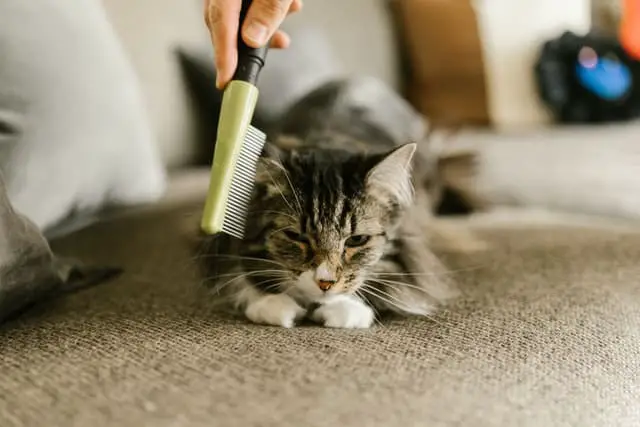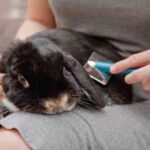
All owners have to spend at least some time grooming our cat. However, this time will depend on whether or not the animal leaves the house, whether it has short or long hair. One of the most important hygiene and maintenance jobs for your pet is brushing. At Petlifey, we explain how to brush a cat.
Why do cats have to be brushed?
Many cats do not need to be brushed; however, this should be a part of your relationship with them. In addition, it will offer you the opportunity to check if your cat is healthy, and it will be appreciated if it needs help to wash.
If properly held and held, most cats feel secure in their arms.
It is best to brush your cat outside because that way dirt, hair and fleas are kept out of the house. The closest places for brushing are the porch or the bathroom. If you do it indoors, place your cat on a piece of paper or plastic.
Examine its ears, eyes and feet, and clean its ears with a cotton ball dipped in olive oil and the eye area with a damp cotton ball. Observe her teeth weekly and clean them to prevent tartar build-up. File the nails too.
Long-haired feral cats shed in the spring, but domestic cats shed throughout the year, so they need to be brushed daily.
How to brush my cat
Short-haired cats do not need to be brushed daily. Two half-hour sessions a week should be sufficient. If there are areas where the coat is damaged, treat them with a barbed comb.
The process you must follow to brush a cat is as follows:
- Remove dust, hair, or parasites from the cat using a fine metal comb from head to tail.
- A rubber brush can be used with thick short coats.
- A soft bristle brush is best for cats with very short, fine coats.
- Hollow out the cloak with a wash cloth, a piece of silk, or a piece of suede.
To give your feline pet a good brushing, you will need:
- A polishing brush for long-haired ponytails.
- A metal and bristle brush.
- A thick and fine tooth comb for hair.
- A toothbrush for the face.
For oily coats, use talcum powder or buy a dry cleaning product and quickly remove it with a brush. Silk, velvet or leather cloths can be used to shine the hair.
How to brush short-haired cats
From the very beginning, get your shorthair in the habit of getting combed every three to four days. Use a comb with short, bushy bristles.
Start combing it from the neck and continue towards the tail, following the direction of the hair. Pay special attention to the hindquarters and other sensitive areas. Then, comb it again with a rubber brush.
The natural oils in the palm of your hand are excellent for straightening the cat’s hair. Daily stroking can be as effective as brushing.
If your cat has a wound that requires medication, ask your vet to prescribe a powdered medication instead of an ointment. Cats hate them and will do their best to lick them. In contrast, powdered products are less bothersome and accelerate wound healing.
If desired, run a silk chamois through the cat’s fur for the finishing touch.
- First, comb the cat with a fine-toothed metal comb. Look closely for any signs of fleas or parasites.
- Repeat the process with a rubber brush. It will allow you to put more pressure on the fur without causing discomfort to the cat.
- After combing and brushing your cat, run the palm of your hand through her hair and, for the finishing touch, a silk chamois.
How to brush long-haired cats
If you have a long-haired cat, you will need more time to brush it. Apart from the time you will spend brushing it while it dries after each bath, you will need to lavish daily care.
Chunks of stool may stick around the anus and haunches that it will be unable to remove on its own and you will have to do it for them.
Before you start combing your long-haired cat, sprinkle the hair with cornmeal or fuller’s earth and then massage it to spread the powder evenly.
How to undo tangles
To undo the tangles you must use a comb with wide and separated teeth, from the hair. If the tangles are severe, undo all the knots or tangles you may need to cut with the scissors.
Use a wide-toothed comb to loosen tangles. Pay special attention to the haunches, tail and belly. You can comb this part by putting the cat face up on your lap. Turn this routine practice into an enjoyable time and combine affection with play.
Even if you comb it daily, if your cat has very thick hair, it will sweat and tangles will form in the belly area that you will have to cut with blunt-tipped scissors.
Undo the tangles as much as possible with your fingers, and then hold the cat’s fur with one finger to avoid pinching it with the scissors.
If, for whatever reason, you have not brushed your cat daily and tangles have formed that you cannot undo, you should see a cat groomer or your veterinarian immediately.
If you don’t completely remove the knots, the hair will become so tangled that it will painfully pinch the cat’s fur.
How to add volume
Finally, run a soft brush all over the body, including the tail and legs. Finish by brushing it against the grain to give it volume.
You will need a soft brush to add volume to the ruff (the hair around the cat’s neck). And pay special attention to the fingers.
Long-haired cats can have tufts on their feet that are very beautiful but can become as tangled as body hair. To give the final touch, brush or comb the coat against the grain to give it the volume you want and consider necessary.
Brushing the cat after bathing

If your cat’s hair is very dirty or greasy, you will have to bathe it. Your cat probably does not like water, so give all your love and attention so that the bath does not turn into a free-for-all.
Close all doors and windows to avoid drafts. Place a rubber mat in the bathtub or sink to prevent the cat from slipping.
Fill the bathtub with about 2 to 4 inches of warm water and use a steamer to get the cat wet. The water should be at body temperature, approximately 38 ° C.
Lather it up with a baby or cat shampoo. Rinse it with lukewarm water, and dry it carefully with a towel or hairdryer. Avoid drafts until the cat is dry. Comb it carefully.
- Apply cleaning powders to the mantle.
- Blend it into the mantle starting from the tail towards the head.
- Brush the coat completely, removing dust and separating the coat from the skin.
- Use a wide comb from tail to head to make sure there are no tangles, taking special care on the inner parts.
- Clean the eyes, nose and inside of the ears with damp cottons or a small brush.






